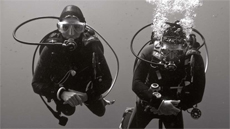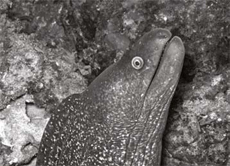




| Home | Features | Club Nights | Underwater Pics | Feedback | Non-Celebrity Diver | Events | 8 August 2025 |
| Blog | Archive | Medical FAQs | Competitions | Travel Offers | The Crew | Contact Us | MDC | LDC |

|

|
 
 |
 |
ISSUE 9 ARCHIVE - THE MEDES ISLANDS, COSTA BRAVA, SPAINAndy York (Reef and Wrecked, Reading)I had always believed there were almost no fish left in the Mediterranean. Then during a brief interlude in my Instructor Development Course, we had a discussion about world–class dive sites and the Course Director said 'for Mediterranean diving, try the Medes Islands in Spain'. 'Where? The what islands?', I said. Now, after two trips to these small rocky islands just off the Costa Brava, I know there are plenty of fish in the Mediterranean, if you go to the right place.In both July 2008 and 2009, a small group of divers from Reading's Reef and Wrecked dive club set off for a short evening Ryanair flight from Luton to Girona. Destination: the Medes Islands, Costa Brava. Once in Girona, we collected hire cars and set off in the darkness to attempt to find our accommodation for the long weekend. We were staying at a bed and breakfast in the hills overlooking the coast run by an English couple that have been living in Spain for over five years. Jane and Baz also have a small dive shop and dive school, Octoscuba, and can arrange most things locally. In fact, Baz was previously a golf pro, so golf lessons are available if the diving is not tiring enough. |
 |
 |
On our arrival we all had a welcome beer or cava and
headed off to bed. Next morning we awoke to Baz, in shorts
and flip-flops, cooking our hearty breakfast while he
informed us of the plan for the day, and for the next few
days. Today we would dive a local site as a check dive,
and the next two days we would dive the Medes Islands.
The first two dives were at a site called Aigua Freda, and true to its name it was absolutely freezing! Here there are a few fish, e.g. bream, schools of sardines, moray eels and scorpion fish – and lots of octopuses. The underwater topography, including a swim-through chimney in the rocks, is interesting, though not spectacular, but a good site for a check dive and to get weighting sorted out. After the diving, it was back to the B&B for an excellent lunch, which is provided for a small supplementary charge and to plan afternoon visits to local villages or just sit and chill-out by the pool. We also had access to a fridge full of beer, wine, juices and sangria, all included in the supplement we had paid for lunch, making this a deal well worth taking. In the evenings, Baz and Jane booked us into their favourite restaurants, usually backing onto the beach, where excellent paella was on offer, with or without squid ink added, as well as lots of other sea food, steaks, pizzas, etc. An alternative option is to have a barbeque next to the pool. |
 |
 |
On days two and three we were woken early for breakfast
and a twenty minute drive down to L'Estartit. This typical
Spanish tourist town had its heyday in the 70's and 80's,
when Brits flocked to the town for a bit of sun, sand and sea.
But for us it was where the dive boats moored up. The diving
is well organised and regimented: we were quickly aboard,
kitting up and preparing for the short boat ride to the
islands, about a mile off the coast.
The Medes Islands are made up of seven individual islands: Medellot, Meda Gran island, Meda Petita, les Ferrenelles, Tascó Gros, Tascó Petit and Carall Bernat. They were first protected from fishing in 1983, and in 1990 a law was passed to conserve the flora and fauna of these islands, including underwater. Over the two long weekends we managed to visit a wide variety of dive sites. In 2008, we dived Bernat, Pota del Llop, Dofi Sud and les Ferranelles. In 2009 it was a little windier, so we mainly dived the more sheltered sites, Pedra de Deu, Dofi Sud and la Vaca. Banded seabream, meagre, mullet, lots of octopuses, moray eels, salema and scorpionfish were there to meet us on most dives, to name only a few of the fish species we saw. |
|
 |
There were also beautiful nudibranchs, some minute,
and a couple of the dive sites were notable for the number
of yellow or purple gorgonian corals, namely at Pota del
Llop and Pedra de Deu. In 2008, we also saw eagle rays on
almost all the dives, but in 2009 the weather did not allow
diving at the outer parts of the islands so, despite the fact
that they were there, no eagle rays were seen. And then,
the groupers, these are the fish for which the Medes islands
are becoming famous and some must have been calling the
islands 'home' since it became protected over twenty years
ago. Many of them are quite large now and very friendly to
the visiting divers, coming in for close inspection but always
keeping a safe distance. It's a very special experience to be
looking into the eyes of one of these large and intelligent fish.
I would even venture to say they are beautiful, though
beauty is of course 'in the eye of the beholder.'
When not diving or taking advantage of the fridge and pool, there are plenty of places to visit, both locally and slightly further afield. Just a couple of hours away is the lively and cosmopolitan city of Barcelona, with a wide variety of architecture and buildings, including those designed by Antoni Gaudi. Or to the north is Figueres, home to the weird, but definitely wonderful, Salvador Dali museum. We queued for an hour and a half to get in, but it was worth the wait. |
 |
|
A few minutes from the B&B is the picturesque,
medieval village of Pals, with little streets and passageways
to explore and an excellent ice cream shop on the main
square. Also close by, is the village of Pubol, an undiscovered
gem. This medieval village is home to the large house that
Salvador Dali bought for his wife and muse, Gala. Inside
there are typically eccentric Dali objects, including a glass
topped table in one of the upstairs rooms, through which it
is possible to see into the room below. In the small garden
there are some statues of the spindly-legged elephants for
which he was famous. The house also has a crypt containing
Gala's resting place, and a stuffed giraffe! If all this culture
gets a bit much, of course there are the local beaches for
which the Costa Brava became famous.
|
||
|
With excellent diving and lots of cultural sites in the local
area, the Medes islands make an excellent destination for
a diving holiday. With the beaches close by and the bigger
more touristy town of L'Estartit on the doorstep, it is easy to
cater for the whole family. Certainly Reef and Wrecked will
be planning another trip in the future; next time it might even
be fun to take in more of Europe, by driving down through
France and the Pyrenees to really make it a grand tour.
I might even take my golf clubs next time. There's just so
much to see and do.
Nearest recompression chamber CRIS-Unitat de Terapeutica Hiperbarica Hospital de la Creu Roja Barcelona Tel: (34) 3 433 1551 Photography by Will Delves |
 | |
Previous article « Diving with the Brazil Swing Next article » Lundy Island Back to Issue 9 Index | ||